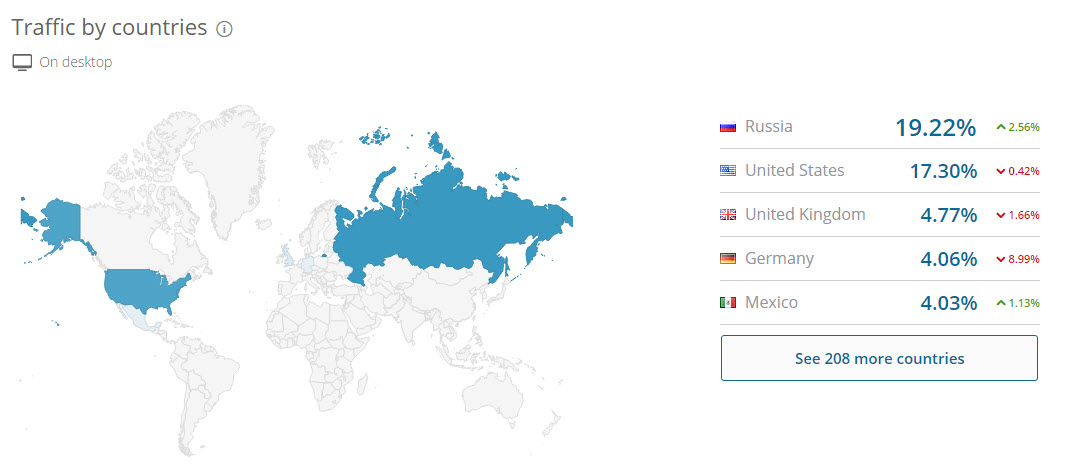RT, Information War, and Billions of Views: Where do the numbers come from?
In September 2015, Alexey Kovalev of Noodle Remover wrote an article in Russian regarding the popularity of RT, in response to a Daily Beast article and the subsequent reaction of RT editor-in-chief Margarita Simonyan. In light of the recent United States Intelligence Community report on Russian influence regarding the 2016 presidential election, we have translated a section of this article and updated it with current figures. Translation and updated sections by Aric Toler, in consultation with the author.
RT and Simonyan herself really like to juggle their relative numbers (“the popularity of RT in Hong Kong and Taiwan is growing faster that of Fox News”) and statements such as “overtaking the online presence of major international news organizations, such as Al Jazeera, Deutsche Welle, Voice of America, Euronews, France 24, and Japanese NHK.“
“Online presence” — this is generally Simonyan’s fetish. Her favorite number is how many billions of views RT gets on YouTube. The first billion (“the first news channel that reached the one billion mark!”) was recognized practically with fireworks, along with national news headlines. In just one of her LiveJournal posts, Simonyan makes the point no fewer than four times that:
Television station №1 on YouTube has more than 2.5 billion views
On RT’s header image on YouTube, they write that they are the “Most Watched News Network on YouTube — Over 4 billion views.” But since when are YouTube view figures an indicator of success for a television channel? RT is the only channel in the world that says that this sort of popularity says so. No one else does, and you want to know why? Because of this:
I’m not saying that RT is cranking up their number of views like this. Moreover, I’m not even sure that they need to do this. But YouTube views are an extremely unreliable metric, as they are easily manipulated. And it’s all for this figure of “more than 2.5 billion views,” now over 4 billion. You know who else has “more than 2.5 billion views?”
2,732,307,064 views (and even more, by the time you read this) for a video clip that cost a few tens of thousands of dollars, which brought and continues to bring its creator millions. It has gotten international media attention, and led to a boom of popularity for contemporary South Korean culture. And their government didn’t spend a single South Korean Won on it.
Well alright, let’s assume that all of these billions of views that RT has gathered are from actual, living people, and not Philippine bots. But what are these people watching billions of times? Here are the most popular videos on the RT YouTube channel:
This is the first page of the most popular video clips, which total somewhere in the neighborhood of 400 million views. Hmm, okay: a homeless guy with a phenomenal voice, earthquakes, tsunamis, a whale crushing a yacht. For the most part, RT did not film these videos — they are recordings from phones, surveillance cameras, or clips from other channels that RT slapped their logo onto.
And now the main question: what does all of this have to do with the stated mission of RT, “to communicate the Russian point of view to foreign audiences”? This mission is announced both on the channel’s website and in numerous interviews with its editor-in-chief, Margarita Simonyan. How does a cell phone clip of a homeless guy who could become a television announcer “communicate the Russian point of view to foreign audiences”? Of the top fifty most popular videos on RT’s YouTube channel — I remind you, that for the channel’s editor-in-chief, this YouTube channel is the main source of pride for her work — the viewer can conclude that somewhere in the far reaches of this terrible world, other than tsunamis and earthquakes, there is a country called Russia where meteorites and planes regularly crash, and the president of this country, Vladimir Putin, is singing “Blueberry Hill.” From the fifty most popular clips on RT’s YouTube channel — this is about a half-billion views — there is exactly one that fully meets the criteria of communicating the “Russian point of view to a foreign audience.” This clip is a news broadcast about an official visit of then-Prime Minister Putin to Denmark.
Well alright, let’s say that we concede the point that RT is the most successful television channel on the internet. It has a website that is many times more popular than Al Jazeera: over 100 million monthly visitors, compared to a bit under 20 million. But, here’s the thing:
More than anywhere, RT.com — and I remind you, the site of the television channel whose main task is to communicate the Russian point of view to a foreign audience — is popular in… Russia itself. Simonyan and other supports of giving RT more money from the state budget loves to talk about how an information war is being waged against Russia, and RT is a weapon in this war, therefore you cannot skimp on funding it. Then, it turns out that we are paying our enemies for this weapon in their currencies (renting RT offices abroad, paying American providers for carrying the RT signal, and so on), and then we load this “weapon” up with wooden bullets and we shoot at ourself. And after all of that, should it be all that surprising that a Pew Research survey (Simonyan loves to cite their surveys when the results suit her) found that, despite the supposed massive popularity and effectiveness of RT, the popularity of Russia across the world has reached an all-time low?



